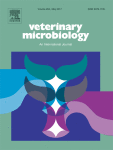View Item
- xmlui.general.dspace_homeCentros e Institutos de InvestigaciónCICVyA. Centro de Investigación en Ciencias Veterinarias y AgronómicasInstituto de VirologíaArtículos científicosxmlui.ArtifactBrowser.ItemViewer.trail
- DSpace Home
- Centros e Institutos de Investigación
- CICVyA. Centro de Investigación en Ciencias Veterinarias y Agronómicas
- Instituto de Virología
- Artículos científicos
- View Item
Bovine rotavirus strains circulating in beef and dairy herds in Argentina from 2004 to 2010
Abstract
Bovine Group A Rotavirus (RVA) is one of the main causes of neonatal calf diarrhea worldwide. The present study reports the genotyping of bovine RVA strains circulating in Argentinean cattle from 2004 to 2010. Additionally, a new set of typing primers was designed and tested to differentiate between G8 and G6 (lineage III and IV) RVA strains.
Bovine RVA was detected in 30% (435/1462) of the tested samples, corresponding to 49% (207/423) of the studied
[ver mas...]
Bovine Group A Rotavirus (RVA) is one of the main causes of neonatal calf diarrhea worldwide. The present study reports the genotyping of bovine RVA strains circulating in Argentinean cattle from 2004 to 2010. Additionally, a new set of typing primers was designed and tested to differentiate between G8 and G6 (lineage III and IV) RVA strains.
Bovine RVA was detected in 30% (435/1462) of the tested samples, corresponding to 49% (207/423) of the studied outbreaks with a similar detection rates in beef (53%; 67/127) and dairy herds (52%; 65/126). The RVA strains circulating in Argentinean cattle belonged to the common bovine genotypes G6 (lineages III and IV), G8, G10, P[5] and P[11]. A different RVA G/P-genotype distribution was found between the exploitation types, with the combination G6(IV)P[5] being by fare the most prevalent RVA strain in beef herds (58%), whereas a more even distribution of G6(III)P[11] (15%), G10P[11] (17%), G6(IV)P[5] (14%), and G6(IV)P[11] (6%) RVA strains was detected in dairy herds. G8 RVA strains were found in two dairy farms in calves co-infected with G8+G6(III)P[11]. A high percentage of co-infections and co-circulation of RVA strains with different genotypes during the same outbreak were registered in both exploitation types (20% of the outbreaks from beef herds and 23% from dairy herds), indicating a potential environment for reassortment. This finding is significant because G10P[11] and G6(III)P[11] strains may possess zoonotic potential. Continuous surveillance of the RVA strains circulating in livestock provides valuable information for a better understanding of rotavirus ecology and epidemiology.
[Cerrar]

Fuente
Veterinary Microbiology 158 (3–4) : 394-399 (August 2012)
Date
2012-08-17
Editorial
Elsevier
ISSN
0378-1135
Formato
pdf
Tipo de documento
artículo
Palabras Claves
Derechos de acceso
Restringido
 Excepto donde se diga explicitamente, este item se publica bajo la siguiente descripción: Creative Commons Attribution-NonCommercial-ShareAlike 2.5 Unported (CC BY-NC-SA 2.5)
Excepto donde se diga explicitamente, este item se publica bajo la siguiente descripción: Creative Commons Attribution-NonCommercial-ShareAlike 2.5 Unported (CC BY-NC-SA 2.5)

